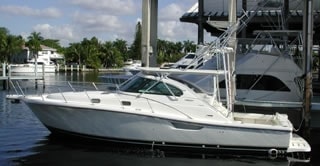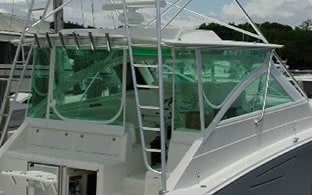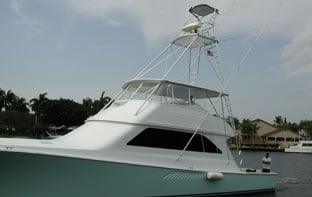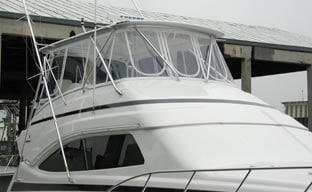
| T-tops and enclosures serve one purpose: to protect passengers and crew from the elements. Owners need to consider how they use their boat, the types of shelter they’ll need and their budget to determine the materials that will serve them best over the long haul. |
Even though fishermen are used to abuse, willing to tolerate great discomfort in pursuit of their sport, modern T-top and enclosure materials are making it possible to stay comfortable in even the worst conditions. And when nature turns nasty, it pays to be protected. This means having the proper materials to keep the sun at bay, the rain out of your face and the wind off your neck.
Special demands are sometimes satisfied by specialized products. In South Florida, Pro-Trim has found a ready market for its Pro-Trim Bimini, a material that couldn’t be better suited to the harsh demands of year-round exposure to sunlight and heat. The material is formed from a recently patented, cold-bendable vinyl typically used in construction. Heat penetration through the material is virtually non-existent on white, and it is 100-percent waterproof. A conservative ten-year limited warranty is offered, and installation is easy with ordinary hand tools. Various trim edgings are available, too.
Shops find this material enjoyable to work with. It can be easily fitted with grommets and is substantially stronger than canvas. Unlike canvas, Pro-Trim cleans up easily with any detergent or vinyl cleaner, and is entirely UV-stabilized. Overall, the cost is comparable to that of canvas, and in some applications, especially T-tops, it is an excellent alternative to canvas. Because Pro-Trim actually repels heat, tops can be very close overhead to provide better sun protection.
While Pro-Trim offers one route, if your needs turn to the more traditional work done in fabric and clear vinyl, things get a little more complicated. To learn more, we turned to Mike Erickson of Canvas Designers in Riviera Beach, Florida. Erickson has been in business nearly 25 years, and has won more than 40 international awards in marine canvas design. He knows his materials.
“There are positive and negatives to each,” says Erickson. “When I begin working with a customer, I give them choices and educate them, then decide what best suits their needs. The design a customer has in mind often dictates the materials best suited to execute it.”
Top Options
“Take the most basic design – the T-top. When you talk about T-tops, there are two versions: the traditional laced-on type or the banded design. The banded variety has gotten a lot more popular in the last four or five years. With this style, rather than a hem-and-a-grommet system that laces to the pipework, an aluminum half-oval rub rail is screwed to the pipe were the lace cord would go and then the top is puled down and compressed between the two pieces of pipe. The result is much cleaner look, and you have the ability to create a watertight enclosure that offers more than just sun protection.
“We also have been moving toward what we call track-to-track enclosures. We take the top track and put it on the bottom of the enclosure and tension it with a zipper that attaches to that. You don’t have to fasten the cover from outboard. You can open and close it from inside. With fasteners you have to stretch and go outside to fasten it down or remove it. Plus, it’s a flatter, tighter fit, and it’s watertight.”

Exercising these new design options will often dictate the materials you need. Erickson walked through a primer on materials. First, the fabrics, with an eye towards the venerable T-top.
Weblon is a traditional vinyl laminate, that is a vinyl skin over a woven mesh. For starters, this material is 100-percent waterproof. For a traditional laced-on T-top that is absolutely waterproof, it’s tough to beat. If you plan on a banded top, this material will require more hand fitting and sewing, as it is relatively stiff and dimensionally very stable. An advantage is that it is available with different colors on each side. A popular application on T-tops is to have the exterior white, for heat reflection, and the underside colored, both for color accent on the boat and to reduce glare at the helm. It’s proven to be tough and durable for the past 20 years, before the advent of newer fabrics, and it still has its applications.
“This product wears well when it doesn’t have to move,” explained Erickson. “Because it is a laminate, if you fold it a bunch, it will delaminate. In a Bimini top, where it is folded a lot, I would choose a different fabric.”
Stamoid is a sailcloth-type woven polyester, with multiple coatings of vinyl. It tends to be lighter, but offers higher strength than Weblon, and it too is 100-percent waterproof.
“Due to the technical aspects of this fabric, the fact that it is less stiff, it looks more like a hardtop when used on a banded top,” says Erickson. “It tends to mold itself into shape.”
Stamoid comes in a wide range of whites, so it is much simpler to match the color of the top to the gelcoat on your boat. “It’s also the most easily maintained surface on the market,” says Erickson, “due to the lacquer coating on the product that gives it excellent cleanability.”
In addition to its double-coated product, Stamoid produces a superlight version that’s ideal for console, chair and rocket-launcher covers. And because it can’t delaminate, it is a great choice in situations where it will be folded, rolled or stored regularly. For instance, it’s a great choice for a waterproof Bimini top.
The third major player is Sunbrel-la, a 100-percent acrylic material that is dyed for exceptional colorfastness. Sunbrella is water repellant and will mist in a rainstorm, so it is not a good choice if you want to stay completely dry. However, the weave is exceptionally cool under a tropical sun, and it offers good sun protection. It is primarily chosen for its intense, permanent colors.

If you use it on a traditional T-top, according to Erickson, it will need to be tightened after a couple of months, as it stretches to shape. However, after the initial tightening it retains its shape and stays put. Bright and breathable, it works best when used in a stable installation. If it’s subject to wear or chafing, it needs to be reinforced.
What about cost? According to Erickson, there’s not a big price difference in the above fabrics, so it’s best to concentrate on using the right fabric for your particular application.
This covers 90 percent of the fabric in the marine industry. There are a couple of other fabrics, according to Erickson, such as the acrylic-coated polyester Top Gun and another coated acrylic, Aqualon. Both are strong in color selection and tend to find favor north of the Mason-Dixon line. A lightweight fabric, Odyssey is used extensively in travel and storage covers because of its excellent chafe resistance.
A Clear Choice
The second type of material you need to know about is the clear products – the windows, if you will. And here, too, there are three major types of material to consider.
The first is roll vinyl, which lies at the economy end of the list. Again, this material is more popular in the north, where UV is less of a problem and use may be limited to a short season. Optical clarity can be a problem with roll vinyl, so if good visibility is an issue, there are better choices. An important consideration is thickness. The thicker the material, the stiffer it will get in cold weather; however, a thicker vinyl is more durable and will also retain its clarity longer.
The second level of clear material is pressed, polished sheet vinyls. These are made by Poly One, Elay and Strataglass. Strataglass is the largerst supplier, and is manufactured in Ft. Lauderdale, Florida. Owner Edison Irvine explained that the manufacturing process starts with using high-quality raw vinyl. “To start with, we have the vinyl calendered for us. We are extremely stringent on the raw vinyl, and it is quite a bit more expensive to begin with. We demand very, very clear material.”
The raw material is pressed under high heat and high pressure between mirror-finished plates that press two pieces of roll vinyl together for a sheet that offers optical clarity, gauged thickness without distortion, dimensional stability and an increased life expectancy.
“Strataglass is the best for absolute clarity, and we are the only company that produces a scratch-resistant sheet that works – nobody else even offers it. It behaves just like vinyl,” says Irvine. “You can sew it or roll it. It is gin clear and stays that way. All vinyl over time gets hazed with high humidity, but I have seen our product used in curtains that were six years old and they still looked like new.”
Lots of today’s bridges have hardtops, and this has changed the type of clear materials that can be used in a bridge enclosure. This opens the door for the top end of the spectrum, the rigid materials.

“Twelve years ago, EZ2CY came on the market when Jeff Smith got a patent on the process whereby he bonded rigid acrylic to soft vinyl and canvas borders,” says Erickson. “This gives you clear, rigid surfaces. The advantages are numerous. There are no wrinkles, no change in dimension due to temperatures, and optical clarity is like a picture window. Acrylic is extremely UV-resistant, so it lasts a lot longer than PVC or soft-vinyl enclosures. I’ve seen enclosures that were 12 years old and still as clear as the day it was put on the boat.” Another advantage of acrylic is that scratches can be buffed out.
Traditionally, rigid materials have been used primarily in larger sportfishermen and motor yachts, due to design limitations. “You can hinge panels up overhead or design them to slide like patio doors, but if you have a console with legs in the way, the panels have to stay fixed,” Erickson points out, but adds that there are applications for smaller boats and center consoles.
“If the T-top allows, you can hinge panels from the underside of the top. Without an instrument box, it works fine. Typically, the front center panel is hinged this way.”
Incorporating these basic materials types, the only limit to the type of top and enclosure you come up with is the size of your boat. Today’s materials are all good – they have to be or they don’t last in the marine market. And the same demands are filtering down to other components.
“Along with better vinyls, better designs and improved fabrics, we use 100-percent Tenara thread made by Gore-Tex,” says Erickson. “It’s a Teflon-based thread that has no stretch and comes with a lifetime warranty. Still, the thread is not the weakest link in canvas work – the zipper is.
“YKK is the major supplier of zippers to the marine industry. The company recently introduced a UV-resistant zipper after Riri introduced its UV D¿cor zipper with five-year warranty. Either zipper is good, and I use both of them. They have been out since the first of the year. They both promise better UV resistance in the polymers, but time will tell.”
If you’d like information on T-top and enclosure materials, contact Mike Erickson of Canvas Designers, Riviera Beach, FL; (561) 848-2111; www.canvasdesigners.com.









